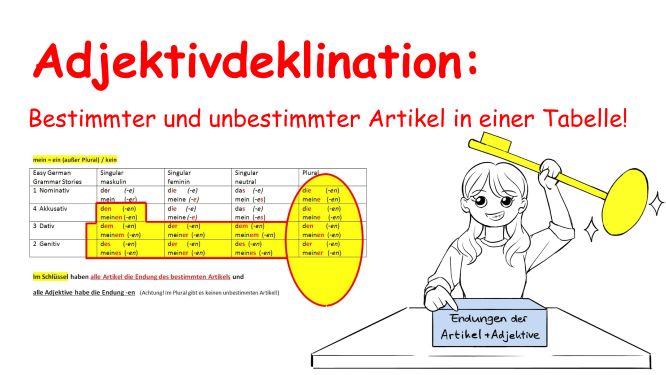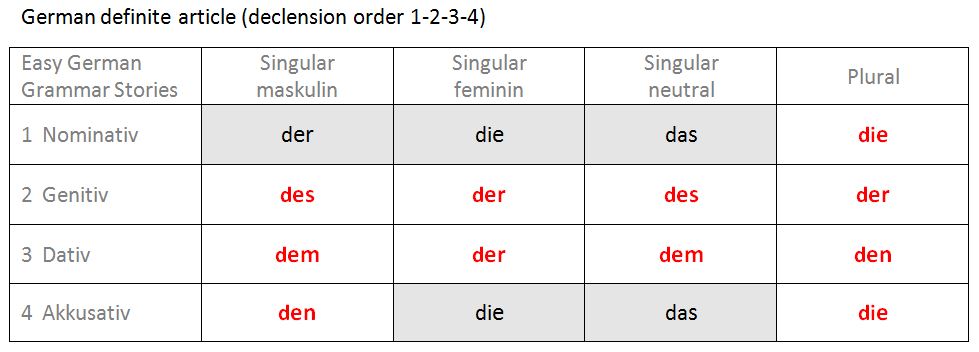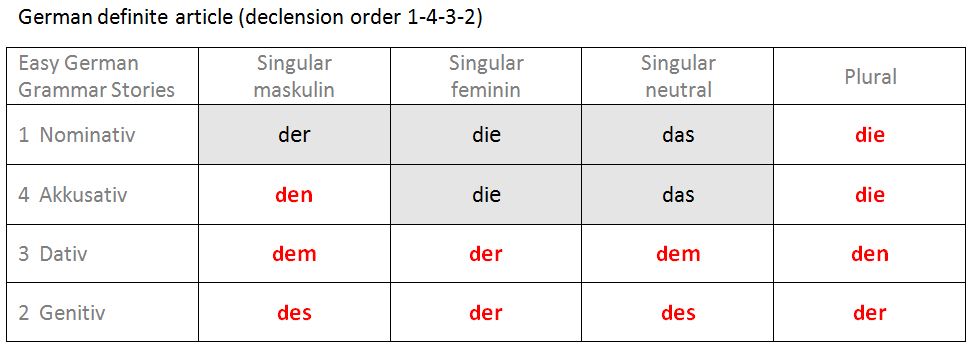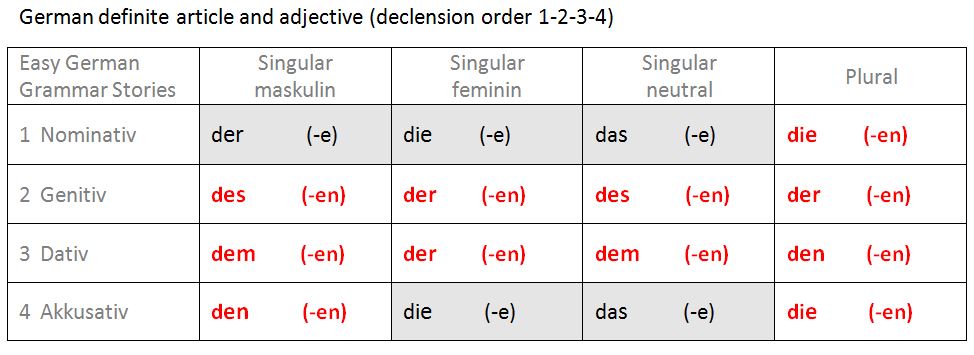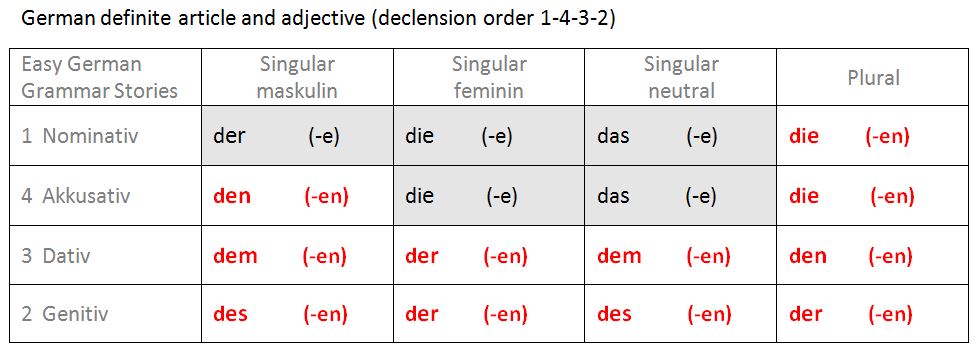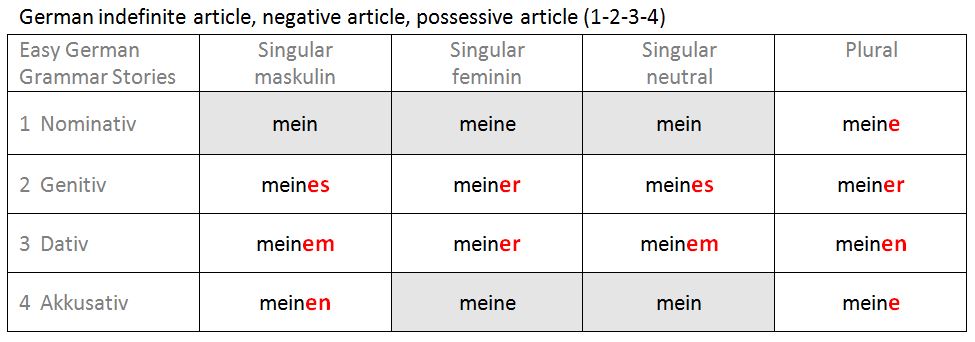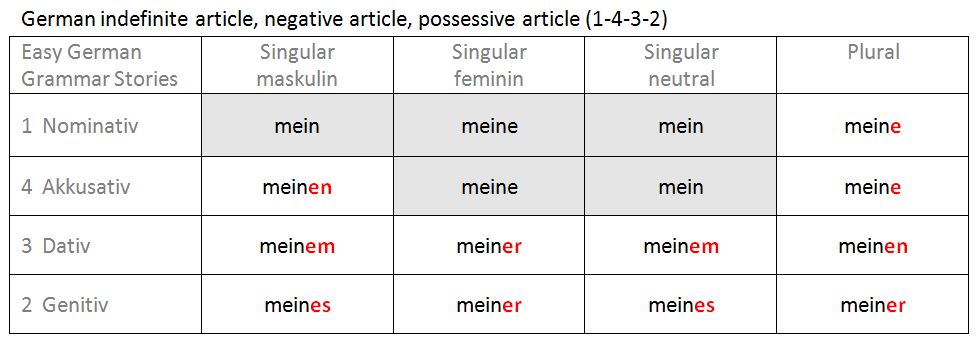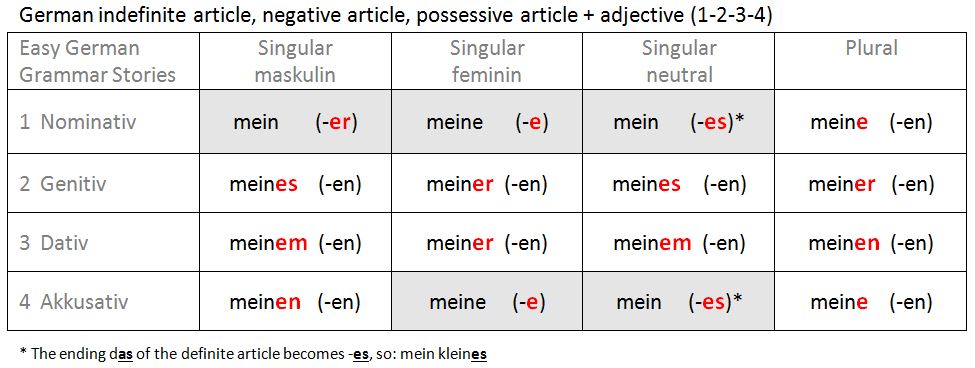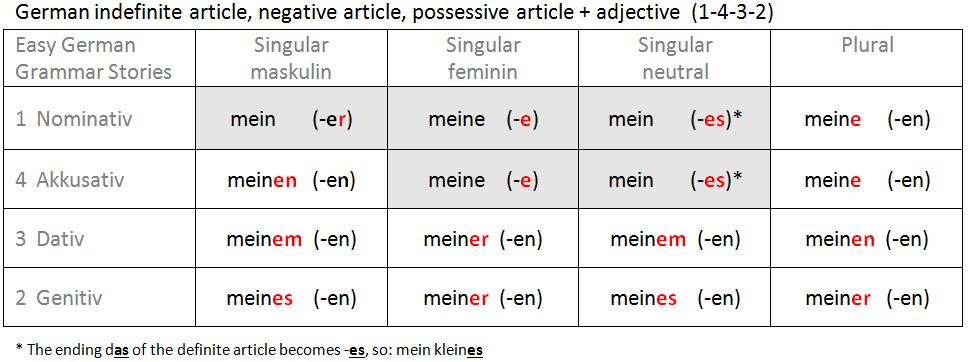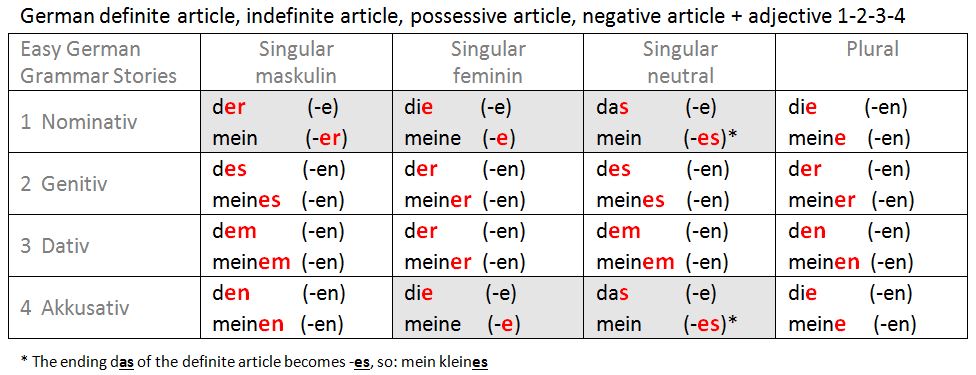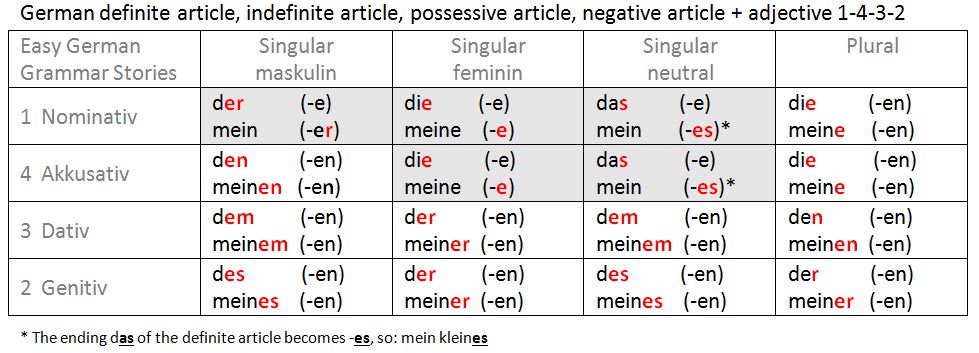der die das - stories
and other helpful books with explanations, tests and MP3-Download for effective German learning.
Easy German books for beginners
German articles and adjective endingsDefinite article, indefinite aritcle, negative article, possessive article + adjectiveThe declension of German articles and adjectives in front of nouns is a problem for many learners of German. Here I’ll give you some tips on how to master declension. |
After each step, you can take a test and see if you can apply what you’ve learned.
I recommend you do these tests before proceeding to the next step.
Tip: If you can declinate the german definite article and only have problems with the adjective endings, go directly to step 3.
German articles and adjectives: step 1 of 4
The German definite article (der, die, das)
What is a definite article?
We use the definite article if we already know something (1.) or if we are specifying something (2.).
(In English the definite article is "the".)
1. We already know the information:
Das ist ein Hund. Der Hund ist groß.
(Das ist ein Hund. = new information = indefinite article = ein = English = a, an)
Der Hund ist groß. = Der Hund is not a new information, as we have talked about him (ein Hund) before.
2. We’re specifying something:
Der große Hund ist schnell. = There are a lot of dogs, but only the big dog is fast.
Die kleine Katze ist braun. = There are a lot of cats, but only the small cat is brown.
Das alte Auto ist kaputt. = There are a lot of cars, but only the old car is broken.
The german articles change (declension) depending on:
- the verb
- the preposition
1. Verb:
Der große Mann hilft dem kleinen Kind.
The verb helfen uses the nominative (1) and the dative (3).
das kleine Kind changes to dem kleinen Kind (dative)
2. Preposition:
Der große Mann geht mit der jungen Frau(3) ins Kino.
After the preposition mit , we need to use the dative (3).
die junge Frau changes to der jungen Frau(3)
To properly declinate the article, you need three pieces of information:
1. You need to know which case you need to use. (depending on verb or preposition)
2. You need to know if the noun is masculine, feminine, or neutral. Find a good way to learn this here: der die das - How to learn German articles easily!
3. You have to know the different forms of the articles. That's what you are going to learn now.
You have to memorize the definite articles. You must be able to immediately recall the right form of the article. For example, dative singular neutral = dem, accusative singular masculine = den, genitive plural = der, ... Maybe this seems too strict to you, but there is no better way. Once you have learned the forms properly, German is so much easier because you can derive all other articles from the definite article!
Actually, it's not that hard, because there are only 16 words!
Masculine and neutral are very similar, as are feminine and plural!
Print the table and study it until you know the definite articles by heart.
Test yourself every now and then and write the articles on a blank sheet of paper.
You can learn the articles in the order 1-2-3-4 or 1-4-3-2. Why?
The order doesn’t matter, learn them whichever way is easiest for you.
Here I created an online exercise for you. You can use it to check whether you can decline the definite article.
Rules
- The nominative is the basic form (der, die, das).
- Accusative feminine and neutral: The definite article keeps the basic form (die, das) !!!
- Accusative masculine: The definite article changes to den.
You might also be interested in: Easy German books for beginners
German definite article + adjective endings
If an adjective follows the definite article, the adjective will have these endings:
- After the basic forms: -e (der kleine Mann, ...)
- After all other forms: -en (dem kleinen Mann, ...)
Summary german definite article and adjective endings:
1. Learn 16 articles
2. Adjectives take the ending -e after the basic forms.
3. Adjectives teke the ending -en after all other forms.
That's all for the definite article. Not so difficult, right?
Here you can download the explanation for the definite article as a PDF file.
Choose the order that is easiest for you:
Are you ready for an online exercise on the definite article?
You can also download and print the exercise for the definite article.
German articles and adjectives: step 2 of 4
The german indefinite article, the possessive article and the negative article +adjective endings
Did you already learn the definite article? If not, please learn the definite article first. (step 1)
The indefinite article, the possessive article and the negative article are declined in the same way. That's why we learn them together.
What is an indefinite article?
We use the indefinite article if we don't know something yet, i.e. if information is new.
(English = a, an):
- Das ist ein Ball.
- Das ist eine Lampe.
- Das ist ein Buch.
- Das sind Bücher. (no article in plural!)
What is a possessive article?
We use the possessive article when something belongs to a person, i.e. when a person owns something.
(English = my, your, his, ...)
- Das ist mein Ball.
- Das ist deine Lampe.
- Das ist sein Buch.
- Das sind meine Bücher.
- ich = mein
- du = dein
- er = sein
- sie = ihr
- es = sein
- wir = unser
- ihr = euer
- sie = ihr
- Sie = Ihr
What is a negative article?
We do use the negative article kein if we want to negate the indefinite article.
(English = not a / not an)
- Das ist kein Ball.
- Das ist keine Lampe.
- Das ist kein Buch.
- Das sind keine Bücher.
Attention!
To keep things simple, I will use the possessive article from now on. All the following rules apply for the indefinite article and the negative article as well. (But: The indefinite article does not have a plural form.
Rules:
- The possessive article * has the ending of the definite article.
- But the basic forms are different. In the nominative singular: mein, meine, mein.
- In the accusative feminine and neutral, the possessive article retains its basic form (as with the definite article).
The German indefinite article, the possessive article and the negative
article + adjective endings
If an adjective follows the possessive article, the adjective receives the following endings:
- On basic forms: -the ending of the definite article
- After all other forms: -en (as with the definite article!)
(Careful: In the plural, there is no indefinite article; the adjective gets the ending of the definite article. For more information go to: adjectives alone before nouns )
For example:
Mein alter Vater ist gesund. Meine alte Mutter ist gesund. Mein kleines Kind ist gesund.
Summary of possessive article (indefinite article and negative article):
- The possessive article (indefinite article and negative article) has the ending of the definite article.
- Nominative singular: The basic forms are mein, meine, mein / ein, eine, ein / kein, keine, kein.
- Accusative feminine and neutral: The possessive article (same like the definite article) keeps the basic form.
If an adjective follows the possessive article, the adjective receives the following endings:
- On basic forms: -the ending of the definite article
- After all other forms: -en (as with the definite article!)
Here, you can download this explanation as a PDF file.
Choose the order that is easier for you:
German indefinite article 1-2-3-4
German indefinite article 1-4-3-2
Are you ready for an online exercise of the indefinite article?
You can also download and print the exercise of the indefinite article.
German articles and adjectives: step 3 of 4:
German definite article, indefinite article, possessive article, negative article + adjective
Did you read my explanations in steps 1 German definite article and step 2 German indefinite article?
This is a summary of all the articles, and you’ll see how easy the declension of German articles and adjectives is once you’ve learned the definite article well.
Attention!
To keep things simple, I will use the possessive article from now on. All the following rules apply for the indefinite article and the negative article as well. (But: The indefinite article does not have a plural form.
In the genitive, dative, accusative masculine and the plural:
- All articles have the ending of the definite article.
- The following adjectives have the ending -en.
Or:
So that you can remember this table better, I have drawn a "declination key" for you here.
Also, check out my Youtube video with the full explanation: Adjektivdeklination: Bestimmter und unbestimmter Artikel in einer Tabelle

Let's look at the basic forms (nominative m, f, n and accusative f, n) more closely:
- After the definite article, the adjective has the ending –e.
- After the possessive article*, the adjective has the ending of the definite article.
* This also applies to indefinite and negative articles
* The ending das of the definite article becomes -es, so: mein kleines
Summary of German articles and adjectives:
1. Genitive, dative, plural and accusative masculine:
- All articles have the ending of the definite article.
- Adjectives after the article have the ending -en.
2. Nominative and accusative feminine:
- All articles and the adjective have the ending -e.
3. Nominative singular masculine and neutral and accusative singular neutral:
- After the definite article, the adjective has the ending -e.
- After the possessive article, the indefinite article and the negative article: the adjective has the ending of the definite article.
* The ending das of the definite article becomes -es, so: mein kleines
4. In the plural there is no indefinite article:
- The adjective then stands alone before the noun and takes the ending of the definite article.
Alte Äpfel schmecken nicht. Nach kalten Getränken habe ich Bauchschmerzen. Etc.
In step 4, you will learn more about adjectives before nouns.
Here you can download this explanation as a PDF file.
Choose the order that is easier for you:
German definite and indefinite article, possessive article and negative article 1-2-3-4
German definite and indefinite article, possessive article and negative article 1-4-3-2
Are you ready for an online exercise on the definite and indefinite articles, possessive articles and negative articles?
You can also download and print the exercise on the definite and indefinite articles, possessive articles and negative articles.
To better memorize the declension, you can do three exercises in which all nouns are either only masculine, only feminine or only neutral.
Continue with step 4: Adjectives before nouns
* Often, we find the order 1-2-3-4 in older textbooks (or in grammar books for Germans). In the newer textbooks, we usually find the order 1-4-3-2. This order has the advantage for the learner that the nominative and the accusative are above each other, and we can immediately see that the nominative and accusative are almost identical. In addition, we usually learn the nominative first, then the accusative, the dative and finally the genitive. (back)


